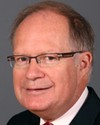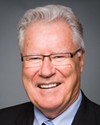Thank you, Mr. Chairman and members of the committee.
I was asked to speak today about search and rescue in the north. I'll start with a brief presentation on CF roles, responsibilities, and posture, and show you the activity rates we have recorded in recent years. I will be referring to search and rescue as SAR during my presentation.
I should mention there are multiple organizations and agencies involved in SAR response. The Canadian Forces and Canadian Coast Guard are responsible for aircraft and vessels in distress within coastal and marine waters. Parks Canada is responsible for lost and missing persons within national park boundaries. Each territory has the mandate for ground SAR--that is, the Yukon, Northwest Territories, and Nunavut, respectively. Volunteers play a significant role, as Mr. Davidson just pointed out. We rely heavily on CASARA to assist in our SAR operations.
I'd like to refer now to the slide deck I provided you, and I'm just going to make some brief comments on the various slides. The first one is entitled “Search and Rescue Regions and MRSC Locations”. We have three rescue coordinating centres serving Canada, depicted here at Victoria, Trenton, and Halifax. The area we're talking about includes offshore waters as well. We have 15 million square kilometres of area we are responsible for in search and rescue. This area essentially runs from the U.S. border to the North Pole, and 1,100 kilometres west of Vancouver and 1,600 kilometres east of Newfoundland. Three of our centres are co-manned by Canadian Forces and Canadian Coast Guard personnel, who are highly trained in search and rescue operations.
A SAR operation will start with notification. Notification passed to any of these rescue coordinating centres will trigger a series of events that ultimately will conclude with a successful or unsuccessful SAR mission, depending. Notification will come from various sources, such as NavCan, next of kin, or emergency locator transmitters, ELTs. I can elaborate on these later, if required.
The coordinating centres will task the most appropriate asset. It may be a Canadian Forces aircraft; it could be a coast guard vessel; and the navy may be involved, and other government department assets too, such as Transport Canada, and provincial and territorial assets. We often charter commercial helicopters, if they are the most logical and convenient resource to use. We use CASARA, as mentioned, and the Canadian Coast Guard Auxiliary. Often there's more than one search and rescue asset tasked in any particular search.
The next chart shows you where our bases are located. We're across the country, from Comox in the west to Gander in Newfoundland. We have primary bases, where our aircraft are on standby 24 hours, seven days a week; and we have secondary capability, such as at Cold Lake, Bagotville, and Goose Bay, where we have some search and rescue capability.
The next chart will show you the primary SAR aircraft resources we now employ and where they are based. These aircraft are all specially equipped for SAR operations, with electronic capability as well as air-dropable rescue equipment, such as pumps, rafts, medical supplies, and shelter; and the load can be tailored depending on the mission specifications. Each aircraft is crewed, in addition to the pilots, of course, with two SAR techs—search and rescue technicians—who are trained in advance trauma, life support, land and sea survival, and specialized rescue techniques, including Arctic rescue, parachuting, diving, and mountain climbing. They're the full rescue capability.
The next chart I'd like to speak to briefly is of the COSPAS/SARSAT system. The notification of an incident is the key to SAR response. Back in the early eighties, Canada was one of the founding member nations to develop COSPAS/SARSAT. Essentially it's a satellite-based detection system for distress beacons. Since we've used SARSAT and COSPAS, we have substantially reduced search times, because we get very rapid location and information, allowing us to pick the appropriate SAR response.
Quite recently, we've actually improved the capability of the COSPAS/SARSAT system, as we converted to 406 megahertz technology, a digital capability with beacons, which now gives us very precise location and very quick alerting capability, and a number of details about the registration of the aircraft and the number of people involved. It helps us greatly in planning the initial stages of any search operation.
As an example, a twin-engine airplane crashed in Iqaluit in December with two people on board. They were both saved. We got a 406 alert, which triggered the system and gave us vital information that allowed us to do a very prompt and quick search and rescue operation.
The next chart is on MAJAID, or major air response capability. It's for an airline-sized air disaster in a remote area. We have pre-prepared and ready-for-dispatch MAJAID kits that contain shelters, provisions, and medical supplies. They're rigged for immediate dispatch and can be rapidly deployed and aerially delivered to the scene of the crash.
The MAJAID kits themselves are just one component of our major air disaster capability. Initially we would launch our primary aircraft, which have some capability to provide shelter and medical aid to people on the ground. We'd follow with MAJAID kits. We'd deploy a forward medical facility, and then we'd start the medical evacuation. We have a plan to support MAJAID that includes not only the military, but territorial responsibilities and other government agencies. Canada is the only nation with such a capability.
In addition to MAJAID, we have caches of survival equipment throughout the north. They contain clothing and shelters, and can be picked up and dispatched to an incident site as required.
The next two slides list statistics on the number of incidents we have recorded by region for a five-year period. The trend has not changed dramatically over the number of years that we've been tracking this data. These are all types of incidents, from false alerts to actual incidents.
The next one, which is more pertinent to our discussion today, shows incidents that have occurred north of 55 for the last five years. We've recorded incidents from the various rescue coordinating centres. These are categories one and two, which means we actually launched SAR assets on the cases. That doesn't necessarily mean they were distresses, but we had no other choice but to launch. You can see that the numbers are fairly small.
Finally is the chart that illustrates incident distribution. Superimposed on that we have our primary source squadrons and secondary squadrons. I think this chart really illustrates that a preponderance of incidents occur where we are based, and there is no particular part of the north where a large number of incidents take place.
Mr. Chairman, I will conclude my remarks there. I look forward to the discussion.
Thank you.










